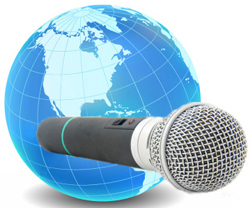
But what about large touring shows that need dozens of wireless mics, in-ear monitors, and intercoms? And what about special events like the Super Bowl, where hundreds of wireless audio, video, and control devices are in use?
To accommodate this kind of use, the FCC will require all TVBD’s to determine their location within 50 meters (using GPS or some other method) and then consult an online database.
The database will send the TVBD a list of available TV channels that are safe to use at that particular location; the device can’t transmit until it receives this list.
A wireless mic user just needs to register the date, time, and location (in latitude and longitude) of their event along with the TV channels being used by their wireless gear in the database, and any TVBD within one kilometer will stay off of those channels.
The Order is quite liberal in defining who will be able to register in the database, referring to “sites with significant wireless microphone use at well defined times and locations.” This is further defined as “instances where one or more microphones are in operation for a period of time not less than one hour.”
For outdoor events that cover a large area such as a race track or golf course, multiple sets of coordinates can be registered in the database to create a larger protected zone.
The database will be created and maintained by a third party, after proposals are solicited and reviewed by the FCC. There could even be multiple providers, but the FCC will require them to synchronize their data every day.
The database administrator can charge TVBD’s a fee to access the database – after all, someone has got to pay for this, right? – but the Order does not mention any fee for a wireless mic user to register.
The Order also requires a “remote kill switch” that can be used against devices that are determined by the FCC to be causing interference. The database administrator would be instructed to send a message of “no channels available” to a single device or to all devices of a particular make and model.
As a third layer of interference prevention, all TVBD’s must utilize spectrum sensing to detect and avoid wireless microphones, TV stations, and other authorized users nearby, whether or not they are registered in the database.
A TV Band Device must scan the spectrum for at least 30 seconds every time it is powered on, and then re-check the channel it is operating on every 60 seconds to make sure that no new microphones have been turned on. If a new mic is detected, the TVBD must cease transmitting on that TV channel within two seconds.
A couple of important issues were not covered in the ‘White Spaces’ Order. The question of when wireless microphones must cease operating in the 700 MHz Band (actually covering 698-806 MHz, or TV channels 52-69) was not addressed.
